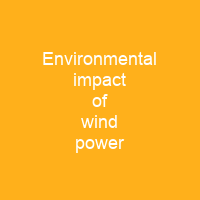The environmental impact of wind power is relatively minor when compared to that of fossil fuel power. Wind turbines produce negligible amounts of carbon dioxide, carbon monoxide, sulfur dioxide, nitrogen dioxide, mercury and radioactive waste when in operation. Wind power doesn’t consume water for continuous operation and has near negligible emissions directly related to its electricity production.
About Environmental impact of wind power in brief

Wind turbines also generate noise, and at a residential distance of 300 metres this may be around 45 dB; however, at a distance of 1. 5 km, most wind turbines become inaudible. However, when improperly sited, data from the monitoring of two groups of growing geese revealed substantially lower body weights and higher concentrations of a stress hormone in the blood of the first group of geese who were situated 50 meters away compared to a second group which was at adistance of 500 meters from the turbine. The National Renewable Energy Laboratory maintains a database of the scientific literature on the subject, However, many details, as well as the overall impact from the growing number of turbines, remain unclear. A summary of the existing field studies compiled in 2010 from the National Wind Coordinating Collaborative identified fewer than 14 and typically less than four bird deaths per installed megawatt per year, but a wider variation in the number of bat deaths. Like other investigations, it concluded that some species are known to be harmed more than others and that factors such as turbine siting can be important. The land between the turbines and access roads can still be used for farming and grazing. The most common wind power installations in the U.S. are in the Midwest, where carbon dioxide emissions of wind turbines ranged from 13 to 33 Gt per year.
You want to know more about Environmental impact of wind power?
This page is based on the article Environmental impact of wind power published in Wikipedia (as of Nov. 30, 2020) and was automatically summarized using artificial intelligence.







